Down Jackets vs. Synthetic Jackets
All the rage at the moment, Synthetic Jackets, also known as padded jackets or quilted jackets, get their name from the pattern of stitched sections filled with insulation to give it a ‘puffy’ look.
A synthetic jacket, on the other hand, is typically made of synthetic materials such as polyester or nylon and is filled with synthetic fibres that mimic the insulating properties of down. The fibres are usually arranged in small, quilted pockets that give the jacket its distinctive puffy appearance.
In terms of care and maintenance, down jackets and synthetic puffer jackets require different approaches. Down jackets require more careful cleaning and maintenance than synthetic puffer jackets, as the feathers are delicate and can be damaged by harsh chemicals or high heat. Down jackets should be washed using a gentle detergent, dried on a low-heat setting or air-dried to prevent damage to the feathers. Synthetic jackets, on the other hand, are much easier to care for and can be washed in a regular washing machine using a standard laundry detergent.
On the other hand, a down jacket is a type of insulated jacket that is designed to keep the wearer warm in cold weather conditions. The primary technical quality of a down jacket is its insulation, which is typically provided by the down feathers of ducks or geese. Here are some of the key technical qualities of a down jacket:
Insulation: The down feathers in a down jacket provide excellent insulation by trapping air in small pockets, which helps to retain body heat and keep the wearer warm.
Lightweight: Down feathers are incredibly lightweight, making down jackets easy to wear and carry.
Compressibility: One of the key advantages of down insulation is its compressibility. A down jacket can be easily compressed and packed into a small size, making it ideal for travel or outdoor activities where space is premium.
Warmth-to-weight ratio: Down insulation has a very high warmth-to-weight ratio, meaning that it provides a lot of warmth relative to its weight.
Water-resistant: Many modern down jackets are treated with a water-resistant coating that helps repel moisture and keeps the down insulation from getting wet.
Breathability: While down insulation is excellent at trapping heat, it can also be quite breathable, allowing moisture and sweat to escape from the jacket and keeping the wearer dry and comfortable.
Durability: A well-made down jacket can be incredibly durable and long-lasting, making it a great investment for cold-weather activities.
Down Jackets vs. Fleece Jackets
Both are must-have cold-weather essentials. A fleece jacket is a type of jacket that is made from synthetic materials that mimic the insulating properties of wool. Fleece jackets are often used in a variety of outdoor activities and technical sports because they are lightweight, warm, and wick moisture away from the body. Specifically, fleece jackets can be used for activities such as hiking, camping, and other outdoor pursuits. Fleece jackets are also popular for casual wear and can be worn as an outer layer in mild weather or as a mid-layer under a heavier jacket in colder conditions.
| Pros | Cons |
| Extremely soft | Not windproof |
| Lightweight | Not waterproof |
| Durable | Prone to static |
| Moisture-wicking | Minimum carry space |
| Great Mid-layer |
Explore Men’s and Ladies Fleece.
Down Jackets vs. Softshell Jackets
A softshell is a very versatile jacket made of soft, flexible fabric, usually stretch-woven polyester or nylon and elastane. Similar to fleece (and sometimes even featuring a fleece inner), they can be worn as a mid-layer in severe weather or as an outer layer in moderate weather. They are well-insulated, lightweight and breathable. It differs from fleece in that its outer layer offers slightly more protection from the elements, with water-resistant and windproof outer fabric. Softshells are often designed for active use like hiking, climbing, running and cycling.
| Pros | Cons |
| Wind & water resistant | Not suitable for extreme weather |
| Soft inner lining | Styles differ greatly |
| Breathable | |
| Great Mobility | |
| Moisture-wicking |
View Men’s and Ladies Softshell Jackets.
Down Jackets vs. Rain Jackets
Rain jackets are specifically designed outerwear constructed to keep the wearer warm and dry in cold, wet, and windy conditions. They are typically made from waterproof and breathable materials to protect the wearer from the elements while allowing moisture to escape. A rain jacket generally has a high water column rating to wick away moisture off its surface. They also often feature peaked hoods to keep water off your face.
| Pros | Cons |
| Waterproof | Not always compressible |
| Well Insulated | Heavier |
| Suitable for moderate to heavy rain conditions | Less comfortable inner material |
| Hooded | Inner makes small noises when moving (swishy) |
| Well insulated |
View our Men's and Ladies Rainwear.
Down Jackets vs. Windbreakers
Windbreaker jackets are designed to help protect the wearer from windy and light rainy weather conditions. They are typically made from lightweight, water-resistant materials like nylon or polyester, and offer some insulation to help keep the wearer warm. Windbreaker jackets are popular for outdoor activities like hiking, running, cycling, and camping. They are also often worn as a casual jacket in milder climates or during transitional months when the weather can be unpredictable.
| Pros | Cons |
| Windproof | Little insulation |
| Water repellent | Not suitable for extreme weather conditions |
| Lightweight | |
| Breathable | |
| Portable |
View our Men's and Ladies Windbreakers.
View our whole Jacket Range.
Read more blogs by First Ascent.





